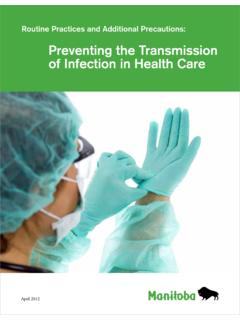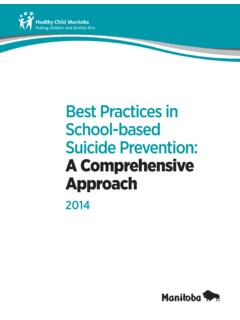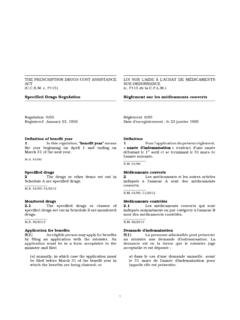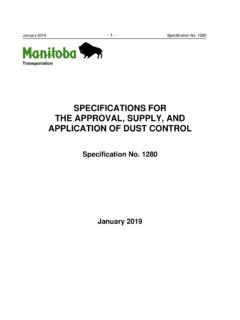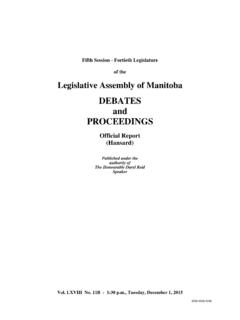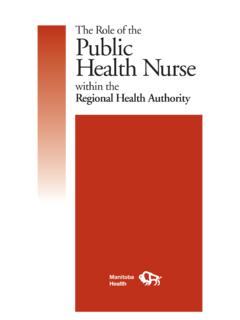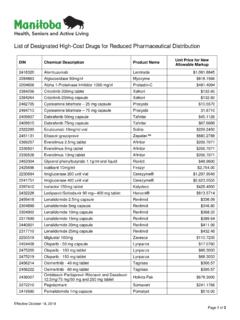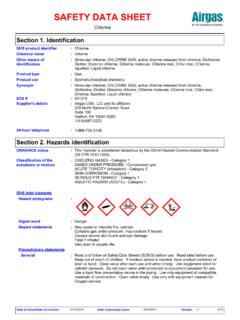Transcription of Water Storage Tanks
1 This fact sheet is intended to be a general reference for cistern users. For detailed information on cistern construction and material standards, owners should refer to Canadian Standards Association (CSA) B126 Series-13 on Water cisterns. Water Storage Tanks , also known as cisterns, are primarily used to store Water for domestic and consumptive purposes in households or are typically found in areas where a potable Water source is not available in the community, the area yields low well Water capacity, or the groundwater quality is poor. Cisterns can also be used to store Water :a) to supplement a low yielding private Water wellb) as an emergency Water supply c) for seasonal/occasional useRainwater CollectionHome and business owners that collect rainwater in a cistern for the purpose of watering gardens and lawns should not drink the Water .
2 Water runoff collected from a roof into a cistern may contain contaminants, including harmful bacteria from bird droppings and other HaulingCistern owners using the Water for drinking and domestic purposes should hire the services of an approved bulk Water hauler for Water supply. Under The Public Health Act regulations, bulk Water haulers must obtain a valid permit to sell or convey Water for sale for domestic purposes. The Water hauling vehicle and associated equipment must be designed, operated and maintained in a sanitary manner to ensure that Water does not become contaminated and pose a risk to public health. For more information on the Bulk Water Hauling Guidelines and approved haulers, please visit the Manitoba Health website at: used for domestic purposes should never be filled with Water from an untreated Water supply, lake, or river.
3 Consuming untreated Water , especially from surface Water sources, can make you sick. Surface Water must be properly filtered and disinfected prior to any consumptive use. Construction MaterialReinforced concrete, fiberglass, polyethylene, concrete and steel can be used to construct cisterns. The use of polyethylene (PE) plastic and fiberglass is increasing as these materials are waterproof and do not rust. Size, shape and cost typically influence material selection. Water Storage Tanks (Cisterns)Drinking Water and your healthCisterns are usually pre-fabricated. Larger units may be custom fabricated or cast in place. The material and any internal coatings must be suitable for potable Water use. Cisterns, including all of their components must be certified to NSF/ANSI Standard 61 : Drinking Water System Components Health Effects ( ).
4 Basic Design Components Detailed information on cistern design, construction materials, manufacturing practices, testing methods, and markings is available in Canadian Standards Association (CSA) B126 Series-13 standards (see ). Some general information is provided below. Storage Reservoir: The cistern s size depends directly on how much Water is used and how often Water is delivered by the Water hauler. Assuming the average person uses 300 litres a day, and on average there are 3 members per household, the average Water demand for a household is 900 litres a day, or about 200 imperial gallons per day. Therefore, household cistern volumes are typically 5500 litres to 7500 litres (about 1200 to 1650 imperial gallons). A larger or smaller volume may be suitable based on household size, Water demand, and Water delivery frequency.
5 A float switch and alarm can be installed to indicate a low Water level in the a cistern will affect the quality of the Water . Over time, the chlorine (disinfection) residual which helps control bacterial growth in the cistern and Water pipes will dissipate. Storing Water too long may also affect its taste and odour. Refilling the cistern once a week is ideal. A Water supplier should be able to assist you in determining an appropriate size for your cistern. The higher the frequency of Water delivery, the better the Water quality will be. The cistern size should balance the additional cost of refilling with the need to maintain fresh clean Water . If you have concerns over the age of the Water and chlorine residuals found in a Water hauling truck, you can request that the Water supplier test the chlorine residual in the Water upon delivery and prior to refilling.
6 chlorine test kits are also available from swimming pool suppliers and chemical suppliers. Adding some chlorine to cistern Water that has been stored for a period of time past a scheduled refill will help maintain a chlorine residual (see Continual Disinfection of Cistern Water ). Access Hatch: The cistern should allow entry for inspection, maintenance, and cleaning through an access hatch or port. The access hatch lid must be lockable and designed to prevent entry of surface Water runoff and insects, or vandalism, Vent: Air flow should be provided by an appropriate air vent located at least metres (about 24 inches) above ground level. The vent should be screened and opening facing downwards towards the ground surface (gooseneck vent) to prevent surface contaminants and small debris from entering the Port: A fill port should be used to prevent hoses, debris, and other contaminants from entering the cistern at the time of refilling.
7 Fill ports equipped with cam locks and screening are an option to prevent entry of contaminants into cisterns. Withdrawal Pipe with Screen: The withdrawal pipe, which is the connection between the dwelling/business and the cistern, should be installed approximately 10 to 15 centimetres (about 4 to 6 inches) above the bottom of the cistern. This will reduce the possibility of sediment that collects at the bottom from entering the plumbing Pump and Pressure Tank: Underground Storage Tanks require a Water pump and pressure tank to draw Water from the cistern for distribution throughout the dwelling/business. Well Water and your healthCistern Placement There are no regulatory requirements for cistern placement in Manitoba. However, it is recommended that cisterns be installed in an area that will allow easy access for Water haulers and for maintenance and cleaning.
8 Depending on the situation, cisterns can be installed underground or above ground. Underground cisterns should be located below the frost line (often metres or approximately 8 feet is assumed), or the cistern should be adequately insulated. Adequate insulation should also be provided for above ground cisterns and their components to prevent cisterns should be installed a safe distance from possible contamination sources. The Onsite Wastewater Management Systems Regulation ( 83/2003, under The Environment Act) requires septic Tanks and aerobic treatment units to be set back at least 3 metres (about 10 feet) from a cistern. Other possible contamination sources that you should consider when placing a cistern that do not have regulation set back distances include:i) septic fields (minimum of 15 metres or about 50 feet)ii) chemical Storage areas (minimum of 30 metres or about 100 feet)iii) trees (depending on root size)iv) animal corrals and pensAdequate bedding should be provided during the placement of underground cisterns so the cistern is properly supported.
9 A cistern supplier or installer should be able to help you with determining the appropriate material and amount of material required for bedding. Precautions should be taken to limit the potential for groundwater infiltration, hydraulic uplift, and for surface Water to pond above an underground cistern. Above ground cisterns installed in basements or crawl spaces must be installed in such a way as to allow easy access for routine cleaning and disinfecting. A minimum of 1 metre (about 3 feet) of space should be maintained between the access hatch of a tank and any overhead building features such as floor joists, ceilings, beams, etc. If this is not feasible, then installations should include a trap door above the tank to facilitate CisternsCisterns should be periodically cleaned and disinfected.
10 Over time, the loss of chlorine residual can lead to microbial growth, sediments and sludge can accumulate in the cistern, or insects and debris may have fallen in. NEVER ENTER A CISTERN UNLESS YOU ARE PROPERLY TRAINED IN CONFINED SPACE ENTRY. Do not use an ammonia-based cleaner to clean a cistern as ammonia reacts with chlorine to produce a hazardous gas. Precautions and regulations related to confined space entry must be followed if entering a cistern. For more information regarding working in confined spaces, contact SAFE Manitoba (204-945-6848, ). Cleaning and disinfection of a cistern should be done once a year, and following: construction, repair or maintenance work on the cistern flooding in the area of an underground cistern a period of non-use sampling which indicates the presence of bacteriaPreparing to Clean:The best time to schedule a cleaning is at the end of a Water use period just prior to a refill.
